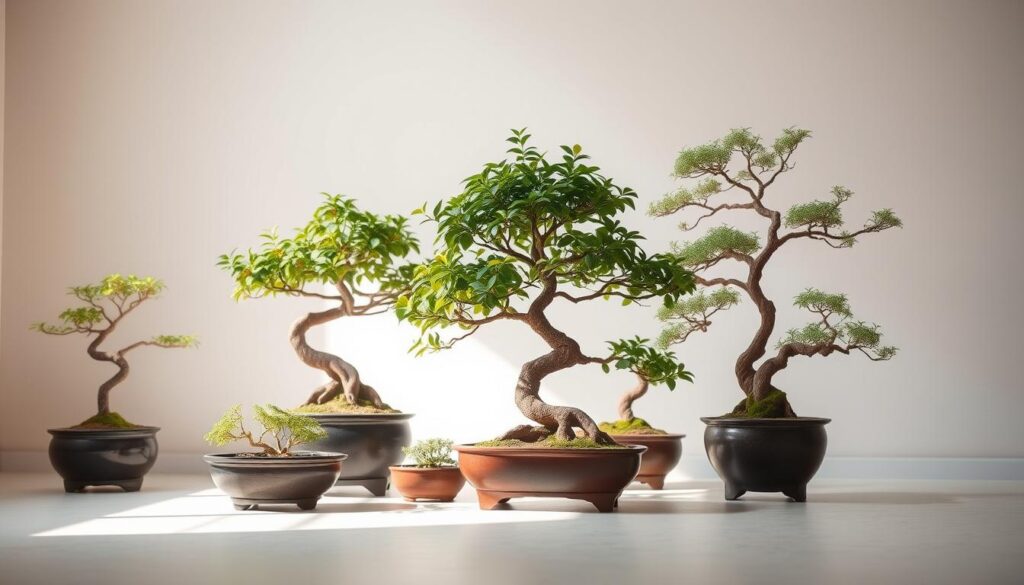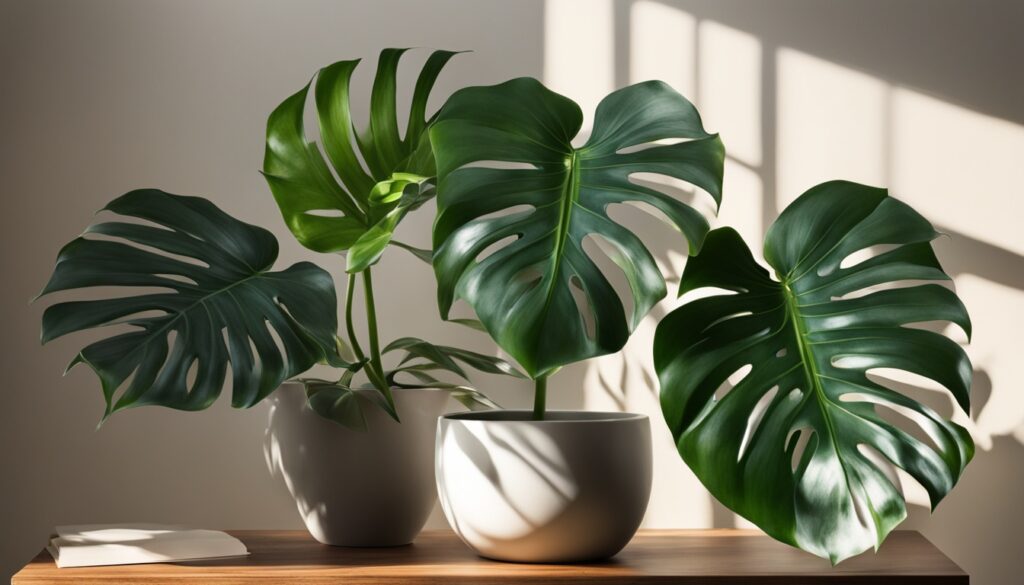Are you fascinated by the idea of bringing bonsai art into your home or office? This expert guide shows you the top 5 bonsai trees for indoor growth. These trees can transform your space with their beauty. They also improve air quality and bring calm, making them perfect for today’s homes.
Key Takeaways
- Discover the top 5 bonsai tree varieties perfect for indoor environments
- Learn expert tips on selecting, caring for, and maintaining thriving indoor bonsai
- Explore the benefits of incorporating bonsai trees into your living and working spaces
- Understand the unique growing conditions and requirements for successful indoor bonsai cultivation
- Unlock the secrets to creating a captivating indoor bonsai display that enhances your surroundings
Understanding Indoor Bonsai: A Brief Introduction
Indoor bonsai trees are tropical or subtropical species that grow well indoors. They are a unique way to enjoy bonsai art at home. Knowing what makes a bonsai good for indoors and how to care for it is key.
What Makes a Bonsai Suitable for Indoor Growing
Species like Ficus, Dwarf Jade, and Fukien Tea are great for indoors. They handle low light, steady temperatures, and controlled humidity well. These plants do well in the stable indoor environment, unlike some that need a cold winter rest.
The Art and Science of Indoor Bonsai Cultivation
- Careful pruning and shaping to keep the bonsai small and beautiful
- Checking soil moisture and watering as needed
- Ensuring enough light, either from windows or artificial sources
- Keeping the right temperature and humidity for the bonsai’s natural habitat
- Fertilizing regularly to help the bonsai grow strong and healthy
Learning the art and science of indoor bonsai care lets enthusiasts create and keep beautiful mini landscapes. These bring the peace and beauty of nature into our homes.
Why Choose Indoor Bonsai Trees
Indoor bonsai trees are perfect for city folks with little space. They make your home look better and connect you to nature. Plus, they help clean the air and are a calming hobby.
These trees are easy to care for. Species like Ficus retusa and Dwarf Jade do well indoors. They need a bit of sunlight and regular water. This makes them great for busy professionals and urban residents who want a compact houseplant.
- Enhance interior décor with miniature trees
- Provide a direct connection to nature
- Improve air quality in your home or office
- Serve as a meditative hobby for urban dwellers
- Suitable for compact homes and apartments
Indoor bonsai trees are great for both beginners and experienced bonsai enthusiasts. With the right care, they can bring beauty and peace to your space for years.
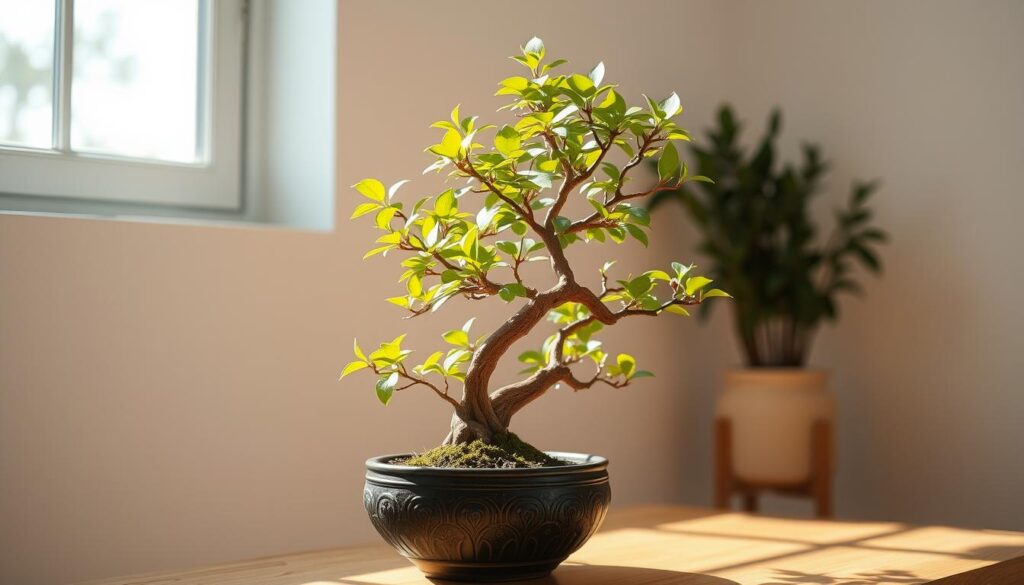
Essential Growing Conditions for Indoor Bonsai Success
To grow thriving bonsai trees indoors, you need to focus on a few key things. Most bonsai species, like Ficus, Brassaia/Schefflera, Sageretia, and Portulacaria, do best in bright, indirect light. Trees like maples and pines are harder to keep indoors. But, tropical and semi-tropical trees, like guava and fig, do well inside.
Light Requirements
Light is key for indoor bonsai health and growth. If natural light is scarce, use artificial lights like fluorescent ones. Placing your bonsai near a south-facing, east-facing, or west-facing window helps too.
Temperature and Humidity Needs
Keep the temperature between 60-70°F (15-21°C) for semi-tropical bonsai. Trees like juniper and azalea need this. They also need humidity levels of 50-60%. Use humidity trays or mist to keep the air right.
Watering Guidelines
Watering depends on the bonsai type. But, water when the soil feels dry. Ficus bonsai, a favorite for indoors, likes moist soil but not too wet. Use drip trays and mist to keep humidity up.
“Providing a cool environment, controlling humidity levels, and adjusting watering schedules are vital for the health and survival of semi-tropical indoor bonsai trees.”
Best Bonsai Tree for Indoors: Top 5 Selection
Choosing the right bonsai trees for indoors is key. Experts say the top 5 include the Chinese Elm, Ficus Retusa, Fukien Tea Tree, Chinese Sweet Plum, and Jade Plant. These low-maintenance bonsai varieties are great for both newbies and seasoned bonsai lovers.
The Chinese Elm is loved for its elegant, curved branches and small leaves. It’s perfect for indoor spaces. Ficus Retusa, or the Banyan Fig, is a tough easy bonsai variety. It can handle many conditions, making it ideal for beginners.
The Fukien Tea Tree is known for its white flowers and slender shape. The Chinese Sweet Plum changes colors with the seasons, adding beauty to any room. The Jade Plant has thick leaves and grows compactly, making it a stunning best bonsai tree for indoors.
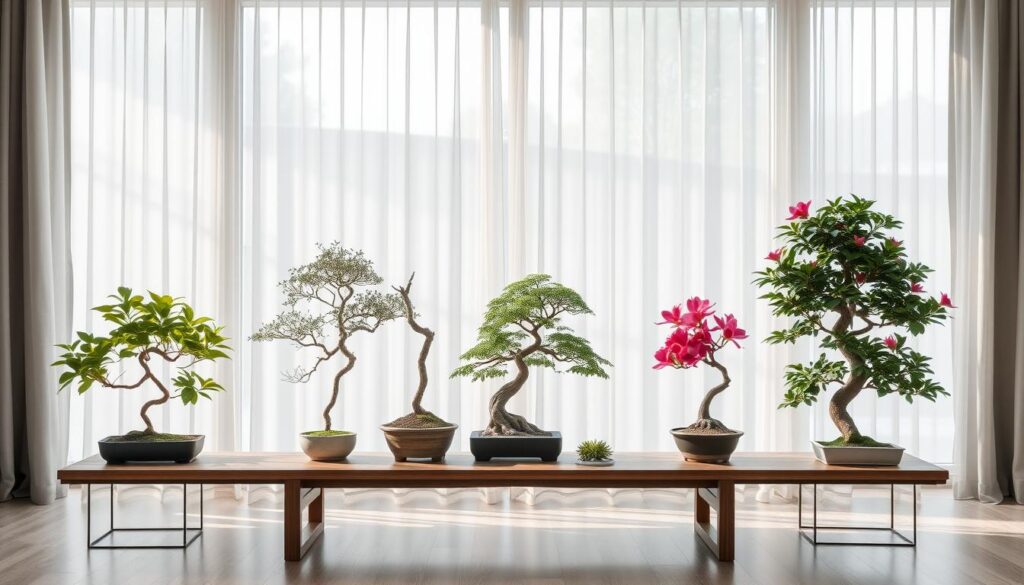
These five bonsai species offer a wide range of choices for indoor fans. They cater to different tastes and skill levels. By picking the right best bonsai tree for indoors, you can add peace and beauty to your home or office.
Chinese Elm (Ulmus Parvifolia): The Perfect Beginner’s Choice
The Chinese Elm (Ulmus parvifolia) is a great pick for beginners in bonsai. It’s tough and easy to care for, perfect for indoor bonsai. It’s a top choice for those new to bonsai.
This tree has small, bright green leaves and a detailed branch structure. It looks elegant and is appealing to both new and experienced bonsai lovers. It’s a bit larger than some bonsai types, but it fits well in indoor spots like windowsills and desks.
Care Requirements
The Chinese Elm bonsai is easy to care for, making it perfect for beginners. It needs moderate watering, bright indirect light, and regular pruning. This helps keep it small and healthy. It’s also forgiving if you forget to care for it sometimes.
Growth Characteristics
The Chinese Elm grows quickly, which is great for bonsai enthusiasts. With careful pruning, it can become dense and lush in a few years. It has a unique s-shaped trunk and detailed twiggy growth, adding to its beauty.
Whether you’re new to bonsai or have been growing for years, the Chinese Elm is a great choice. It’s easy to care for and looks amazing. Its adaptability and beauty make it a perfect choice for indoor bonsai.
Ficus Retusa: The Resilient Indoor Beauty
The Ficus Retusa, also known as the Ginseng Ficus, is a top pick for indoor bonsai trees. It’s loved by many for its shiny, dark green leaves and cool aerial roots.
This bonsai is great for beginners. It’s easy to care for and can grow well in lower light conditions. This makes it perfect for indoor spaces.
The Ficus Retusa is also very strong against pests and diseases. This means it can handle indoor life well. Even newbies can enjoy having one.
“The Ficus Retusa bonsai is a true testament to the resilience and versatility of these remarkable plants. Its unique aesthetic and low-maintenance nature make it a must-have for any indoor bonsai enthusiast.”
Whether you’re new or experienced with bonsai growing guide, the Ficus Retusa is a great choice. It’s easy to care for and looks amazing. It’s a great addition to any low-maintenance bonsai collection.
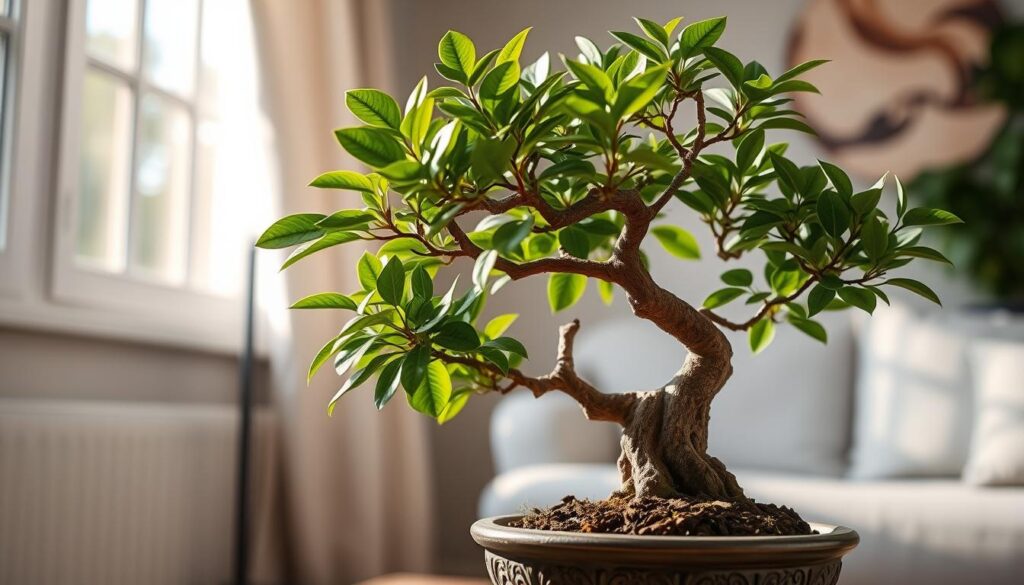
Fukien Tea Tree: Elegant Indoor Performer
The Fukien Tea Tree (Carmona microphylla) is a stunning choice for indoor bonsai trees. It’s known for its small, white flowers and dark green leaves. This tree loves warm, steady temperatures, making it a beautiful addition to any compact houseplant collection.
Flowering Patterns
The Fukien Tea Tree is famous for its many tiny, fragrant white blooms in summer. These flowers enhance the plant’s beauty, making it a favorite among bonsai care tips fans.
Maintenance Tips
- Keep the soil of the Fukien Tea Tree moist but not too wet.
- It needs bright, indirect light to keep its leaves lush and flowers blooming.
- Keep it away from cold drafts since it prefers a warm, stable place.
- Prune and shape it regularly to keep its compact, neat look.
“The Fukien Tea Tree shows the beauty and charm of compact houseplants. Its flowers and leaves are a must-have for anyone who loves bonsai care tips and wants a rewarding indoor bonsai.”
Chinese Sweet Plum: Character and Charm
The Chinese Sweet Plum is a top pick for those who love bonsai trees. It has a unique look with its flaky bark showing off red and tan colors. Its leaves are glossy green with a hint of rusty red, making it very eye-catching.
This bonsai is special because it can grow white flowers and tiny fruits that look like plums. To keep it small and neat, you need to prune it often. This helps prevent it from getting too long.
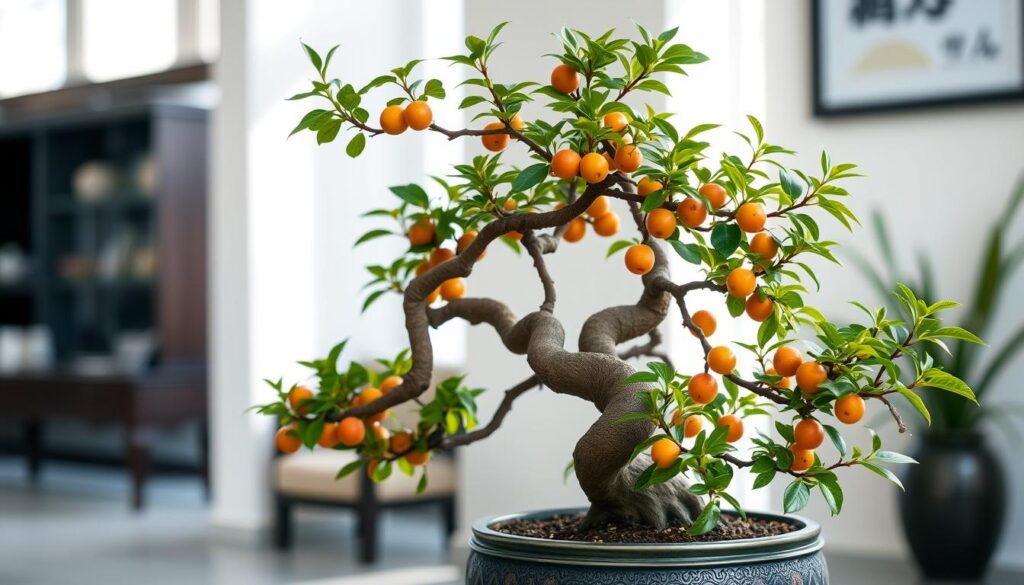
The Chinese Sweet Plum is a great choice for anyone who wants a bonsai tree for their home. It’s small and easy to care for, making it perfect for those who love miniature trees. It adds elegance to any room, thanks to its beauty and easy care.
| Product | Price | Availability |
|---|---|---|
| Chinese Sweet Plum Bonsai | £32.95 | Only 2 left in stock |
| Vitax Bonsai Soluble Feed | £3.50 (43% off) | In stock |
| Fito Bonsai Drip Feed | £1.99 (was £3.50) | In stock |
| Baby Bio® Bonsai Food | £4.99 | In stock |
To make sure your Chinese Sweet Plum bonsai thrives indoors, follow a good bonsai growing guide. This means giving it the right light, watering it correctly, and feeding it well. With proper care, this tiny tree will flourish, adding beauty to your home.
Maintaining Proper Indoor Bonsai Health
To keep an indoor bonsai tree healthy, you need to balance pruning and fertilization. These trees grow in small spaces, so regular care is key to their long life.
Pruning Techniques
Pruning is crucial for the look of indoor bonsai. The method depends on the tree type. It involves cutting off dead or too long branches to keep the tree’s shape.
Trimming new shoots to 2-3 cm is also important. This keeps the bonsai looking artistic.
Fertilization Schedule
Indoor bonsai trees need regular food, especially when they’re growing. Use a balanced fertilizer every two weeks. But, cut back on fertilizing in winter when they grow slower.
| Maintenance Task | Frequency |
|---|---|
| Pruning | Regular trimming of new shoots, hard pruning in spring |
| Fertilization | Every 2 weeks during growing season, reduce in winter |
| Repotting | Every couple of years to maintain health and growth |
By sticking to these bonsai care tips and a bonsai growing guide, your low-maintenance bonsai will flourish. It will keep its beautiful look.
“Proper maintenance is the key to a thriving indoor bonsai. Mastering the art of pruning and fertilization can transform a struggling tree into a true work of living art.”
Common Challenges and Solutions
Maintaining healthy indoor bonsai trees is a big responsibility. Growers often face issues like pests. Aphids, spider mites, weevils, and mealybugs are common pests. They can make leaves look bad and even cause egg sacks on the leaves.
To fight pests, it’s important to check your trees often. Knowing the pest type is key. Then, isolate the plant and use the right pesticides. To prevent pests, spraying weekly with a Plant Invigorator helps. For bad infestations, spraying once a week for three weeks with an insecticide is needed.
Watering issues are another big problem. Too much or too little water can harm your bonsai. It’s important to check the soil moisture and adjust watering based on the environment. This keeps your bonsai healthy.
Not enough light is also a challenge. Too much sun can burn leaves, while too little can weaken the tree. Make sure your bonsai gets enough light, either from natural sources or extra lighting.
Too much fertilizer is another issue. It can make leaves turn yellow and wilt. Stick to a balanced fertilization schedule to keep your bonsai healthy and growing well.
By tackling these common problems, you can keep your indoor bonsai trees thriving. Stay alert, solve problems quickly, and follow good bonsai care tips. This way, you can enjoy the beauty of your indoor bonsai trees for years to come.
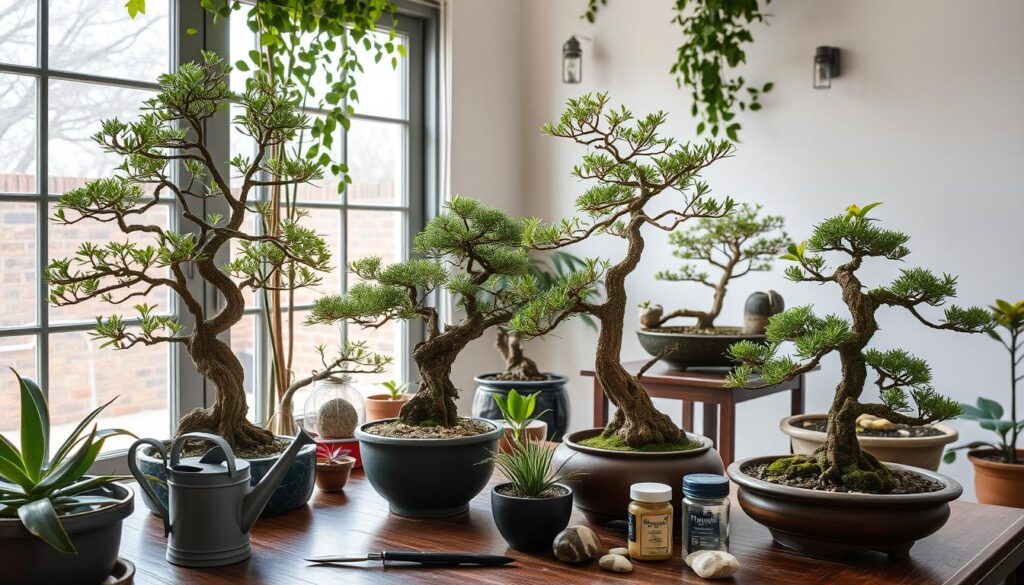
Seasonal Care Adjustments
Caring for indoor bonsai trees needs a careful approach that changes with the seasons. As the weather outside changes, so must your bonsai care. This ensures these small wonders thrive indoors.
In winter, when growth slows, it’s key to reduce watering and fertilization. Too much water can cause root rot, and too many nutrients can lead to bad growth. Keep the moisture right and protect your indoor bonsai trees from dry air by increasing humidity.
When spring comes and days get longer, boost your care. Increase watering frequency to match the bonsai’s faster growth, and use a balanced fertilizer. But watch out for too much sun, which can burn the leaves. Give some shade or partial protection during the hottest times.
- Reduce watering and fertilization in winter
- Increase humidity to offset dry indoor air
- Boost watering and fertilize in spring
- Protect from intense afternoon sun in summer
- Schedule repotting and major pruning in spring or fall
As seasons change, pay attention to your bonsai’s needs and adjust your care. In fall, it’s a great time for repotting and major pruning. This prepares your bonsai for a healthy growth cycle. By keeping up with these changes, your indoor bonsai will thrive and bring joy for years.
“The secret to successful indoor bonsai is understanding their seasonal needs and adapting your care routine accordingly.”
Tools and Supplies for Indoor Bonsai Care
Learning to care for indoor bonsai trees needs the right tools and supplies. You’ll need everything from pruning shears to humidity trays. Each item is key to keeping your bonsai healthy and looking great. Let’s look at the must-haves for every bonsai lover’s collection.
Pruning shears are vital for shaping your bonsai. Choose sharp, high-quality shears for cutting delicate branches. Wire cutters help shape the tree’s structure. A watering can with a fine nozzle ensures your bonsai gets the right amount of water.
Special bonsai soil mixes are crucial for your tree’s health. Humidity trays help keep the air around your bonsai moist. Grow lights are also important, especially in dark rooms, to give your bonsai enough light.
Use small-scale fertilizers made for indoor plants. These nutrients help your bonsai grow strong and green. Remember, a little fertilizer goes a long way.
With the right tools and supplies, you’ll be on your way to becoming a bonsai expert. Enjoy the beauty of these small wonders in your home with indoor bonsai care.
Essential Tools for Indoor Bonsai Care
- Pruning shears
- Wire cutters
- Watering can with fine nozzle
- Bonsai-specific soil mix
- Humidity trays
- Grow lights
- Small-scale bonsai fertilizers
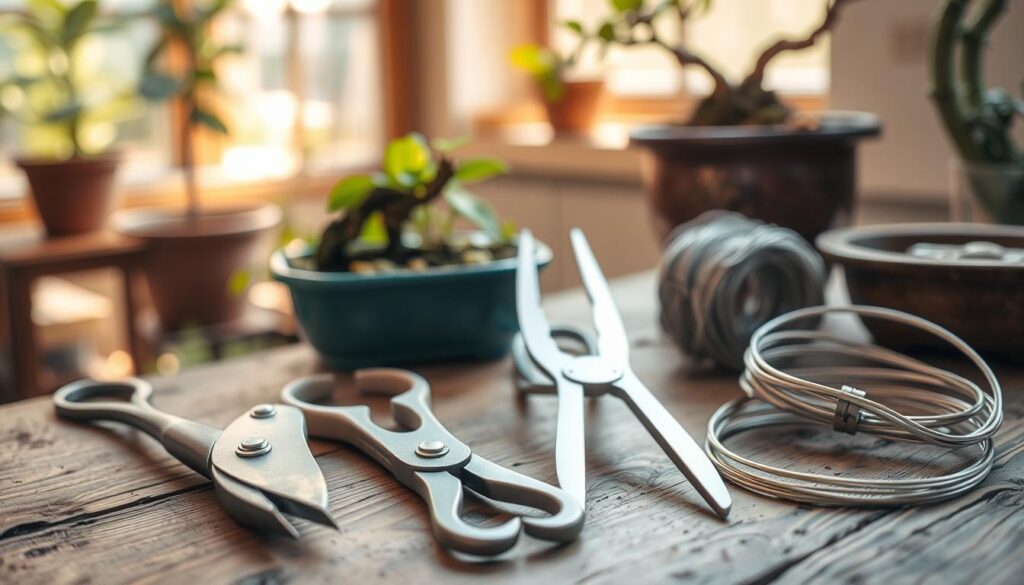
“Caring for bonsai trees is a delicate balance of art and science, and the right tools are essential for ensuring their long-term health and beauty.”
Creating the Perfect Indoor Display
To grow a healthy indoor bonsai tree, you need more than just care. You must also think about where to place it and how it looks. This way, your miniature trees can become beautiful highlights in your home.
Positioning Your Bonsai
Putting your bonsai in the right spot is crucial. It should get plenty of natural light but not too much. Also, avoid placing it near heating vents or cold spots. This helps it grow evenly.
Aesthetic Considerations
The look of your bonsai display matters a lot. Pick pots and stands that make the tree look good and fit your home’s style. You can also group bonsai together to make mini scenes. This adds beauty and interest to your space.
| Bonsai Positioning Tips | Aesthetic Enhancers |
|---|---|
|
|
By carefully placing your indoor bonsai trees and thinking about how they look, you can make a stunning display. This display will not only show off the beauty of these miniature trees but also fit well in your home.
“Bonsai trees are not just plants, they are living art forms that evoke a sense of tranquility and connection with nature.”
Conclusion
Indoor bonsai trees are a captivating way to bring nature’s beauty into your home. They require the right species and care to thrive. You can choose from a Ficus Retusa, a Chinese Elm, or a Jade Tree.
Each bonsai has its own needs for light, temperature, and humidity. Keeping a regular watering and fertilizing schedule is also key. This guide will help you care for your indoor bonsai.
By following this guide, you can enjoy the peace that bonsai trees bring. They can turn your home into a peaceful oasis. With care and creativity, your indoor space can become a place of beauty.
Start your bonsai journey and watch these trees grow and change in your care. Bonsai art adds elegance and strength to your life. It’s a timeless way to connect with nature indoors.
